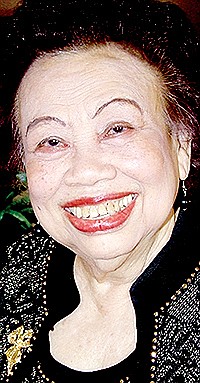It has been nearly five months since Typhoon Haiyan ravaged the central islands in the Philippines on Nov. 8 of last year, killing some 6,000 people, destroying homes and damaging the way of life for many fishing villages on the east side of the country.
A Bella Vista woman is working hard to help those fishing villages, one boat at a time.
How to help
Make donations by calling Cecelia Andersen at (479) 876-7300 or call her to buy homemade eggrolls at $10 for “a baker’s dozen.”
Cecilia V. Gomez Andersen has raised funds to purchase four boats to help fishermen and just sent the money for a fifth one this week.
Andersen has communicated often with her niece, Carla Gomez, who is managing editor of The Visayan Daily Star in Bacalod City in the Negros Occidental, a central Philippine island hit by Typhoon Yolanda, as Haiyan was known to Filipinos.
The typhoon's strength had dropped to a Category 2 when it hit Negros. When it came ashore on the east side of the country at Cebu, Leyte and Samar, it was a Category 4.
"Hurricanes hit the Philippines every year," Andersen said, but Yolanda was different because of its intensity.
"The people band together to help each other," she said.
'Tita Cyl'
Andersen, a former college professor in Michigan and Arizona, came to the U.S. in 1958 on a Fulbright Scholarship and has received numerous national awards for teaching. She and her husband, Roger, moved to Bella Vista in 2005. Roger Andersen was driving through the area on his way to Chicago to visit family. The area reminded him of his native Norway, he said, and he bought a house here shortly after that.
"The first thing I saw was the lakes, and I was sold," he said.
But his wife has never lost her connection to her homeland.
"All Filipinos in America were worried about their fellow Filipinos after the typhoon," she said.
One of the Philippine groups lending a hand is Negros Volunteers for Change, whose members believe that ordinary citizens can make a sustainable difference rather than waiting for government assistance that may never come, Andersen said.
By the fourth day after the typhoon, NVC was providing relief with rice, water and noodles. The group turned houses into packaging centers, Andersen's niece told her, in Bacalod City, where water and electricity were largely intact.
"I'd like to take Tita Cyl (Tita in the Philippines means aunt and Cyl is her nickname -- Aunt Cyl) on a personal note," described Millie Kilayko, president of NVC. "To me, she was always my friend Carla's aunt who would come home and remind me, through her presence, of what 'woman of substance' truly means.
"She'd dance the night away and spend countless hours looking for the right shoes, but she'd also spend equally countless hours going back to her hometown and help build classrooms in her alma mater and equip its library with books. She'd toss caution to the wind and engorge her diabetic self with countless sweet mangoes, yet she'd seriously take time and block off distraction to write a book!
"Am I surprised that she has thrown herself into the task of raising funds to help replace the boats lost by our fishermen to Typhoon Haiyan?" Kilayko said. "Of course not! I knew she would raise more than one, and true to form, she did."
Staying afloat
NVC started its efforts to assist fishermen by building wooden boats with wood from Negros, Andersen said. Filipinos from everywhere, including Japan, Hong Kong and Canada, helped fund the "Peter Project," named after St. Peter, who was a fisherman.
In Northwest Arkansas, Andersen began her own fundraising effort. She and husband Roger attended an American Legion dance, and she made an appeal for funds, raising $200. The Presbyterian Church of Bella Vista, of which she is a member, donated more than $200 after her plea. Her PEO sisters also raised funds.
In all, she has sent about $2,600 to her homeland.
The fisherman who received Bella Vista Boat No. 1 lost his wife and four daughters to the storm. Only he and his son survived. He gave the money from his first catch to his church and split the money from the second catch between himself and the relief effort. He wanted the church to use the money to buy a boat for another fisherman.
In addition to purchasing boats, part of the funds raised by Andersen went to Mingo Meals, which feeds children so they won't be malnourished, she said. The meals are provided for six months while the parents get back on their feet.
"They are very nutritious meals," Andersen said. "My niece helped organize things by getting trucks to transport the meals out to hard-hit areas."
By Christmas, 1,400 wooden boats had been built, Andersen said. Her niece wrote in the paper of her concerns about using up the supply of wood and encouraged organizers to do something else.
So, Fiberglas boats are now being built by NVC.
"Wives would cry when their husbands got their boats," Andersen said. Agreements had to be signed by the fishermen stating they wouldn't sell their boats and would use them only for their livelihoods.
The wooden boats cost about $500, but the Fiberglas boats are more expensive, costing approximately $600 each.
"This is typical of Filipinos, who still love their country and send help when they can," she said.
"And even the news about (Andersen) making egg rolls to raise more funds so that we can upgrade wooden boat donations to Fiberglas is no surprise at all," Kilayko added. "It is Tita Cyl, true to form!"
NAN Our Town on 03/20/2014

